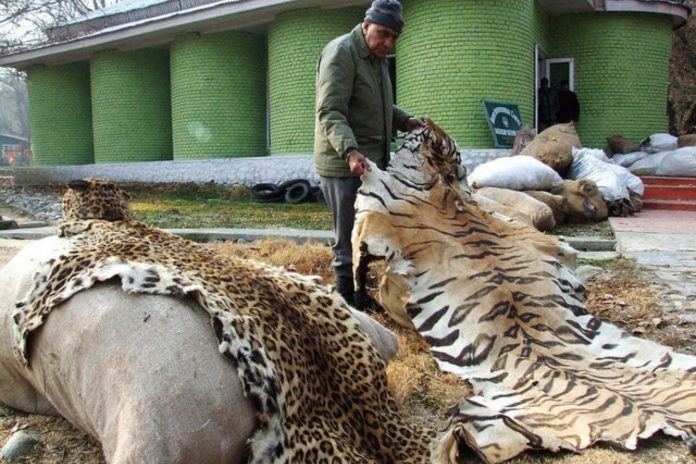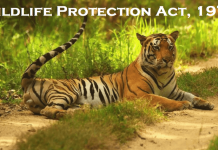This article is written by Mehak Jain who is currently pursuing law at the Hidayatullah National Law University. This is an exhaustive article that aims to deal with trade and commerce in wild animals and the laws as well as provisions relating to it, primarily the Wildlife Protection Act, 1972.
Table of Contents
Introduction
Wildlife Protection has always been a prevalent issue since the oldest of times. In ancient India, environmental protection was a moral duty that was imposed on people by religious scriptures. Cow was worshipped as God, some birds and animals were treated as God’s vehicles or vaahans, and plants such as the Tulsi were considered to be holy. In the pre-constitutional era, few legislations were enacted to protect the wildlife.
The post-colonial era saw a catalytic change in wildlife protection legislation and one such Act was The Wildlife Protection Act, 1972. This Act emphasized on discontinuation from excessive trade and commerce in wild animals and gave safeguards for the same.
Trade and Commerce in Wild Animals
India is blessed with an immense variety and diversity in terms of natural resources. Wildlife is one of the most basic of natural resources which keeps our ecosystem balanced and provides for the needs of humans. Therefore, it’s our responsibility to ensure that this resource is conserved.
In India, the law governing trade and commerce in wild animals is The Wildlife Protection Act, 1972. The Act deals with laws related to the protection of wild animals, birds, and plants with a view of ensuring the ecological and environmental security of the country.
For the purposes of understanding this Act, some essential definitions are-
- Animal- It includes birds, amphibians, mammals and reptiles and their young ones which may include eggs.
- Animal article- It includes any article made from any animal (captive or wild) other than vermin. Also includes articles made from ivory imported in India.
- Wild Animal- Animals explicitly mentioned in Schedules I to IV and are wild.
- Trophy- The whole or part of any animal (captive or wild) other than vermin preserved by any means. For example- Rugs, skin, antler, bone etc.
- Uncured Trophy- The whole or any part of any animal (captive or wild) other than vermin, which has not undergone taxidermy. For example- freshly killed wild animals, musk, etc.
Section 39: Wild animals, etc. to be Government property
The following includes property of the State Government as per Section 39 of the Wildlife Protection Act, 1972-
- Wild animals (other than vermin) which are hunted, or kept or bred in captivity, or hunted in contravention of provisions of the Wildlife Protection Act, or found dead or killed by mistake, or
- animal article, trophy or uncured trophy or meat procured from any wild animal, or
- ivory imported in India and articles made of such ivory, or
- Vehicles/ weapons/ vessels/ traps used for committing an offence as per this Act, and which has been seized in the process.
Where such an animal is hunted in a sanctuary or National Park, then also, it will be the State Government’s property. If a person by some means obtains the possession of the State Government’s property, he/she had to report it to the nearest police station or an authorized officer within 48 hours from obtaining such possession and may even be required to give up such property.
No person is allowed to acquire/keep in his possession, transfer to any person due to any pretext or destroy or damage such Government property without the previous written permission of the Chief Wild Life Warden or the authorized officer.
Section 40: Declarations
According to Section 40, declarations have to be made to Chief Wild Life Warden or the authorized officer about the number and description of any animal/article under his control and other necessary details. However, such persons may be exempted if they have obtained previous permission in writing from the Chief Wildlife Warden or the authorized officer.
Section 41: Inquiry and preparation of inventories
When the Chief Wild Life Warden or any authorized officer receives a receipt of declaration under Section 40 of the Act, he/she is authorized to-
- Enter the premises of the person who gave such a declaration;
- Make inquiries and prepare inventories of animal articles, trophies or uncured trophies, captive animals, and skins( salted and dried);
- Make/ add identification marks on animals/ animal articles/ trophies or uncured trophies.
This Section also forbids counterfeit identification marks/ destroy identification marks given by such officers.
Section 42: Certificate of ownership
If the Chief Wild Life Warden thinks that a person is in lawful possession of any wild animal/animal article, trophy, and uncured trophy, they may for the purposes of Section 40 of the Wildlife Protection Act of 1972, provide such person with a certificate of ownership. They may also mark such an animal article/ trophy/ uncured trophy for purposes of identification.
However, the Chief Wild Life Warden must ensure that such a person has adequate housing facilities and other facilities for maintenance and upkeep of the animal before issuing a certificate of ownership.
Section 43: Regulation of transfer of animal, etc
No person, who has a certificate of ownership for a captive animal, animal article, trophy(or uncured trophy) in his/her possession is allowed to transfer/shift by the means of a commercial transaction that animal. In case of such transfer, to or from another state, he has to report the same within 30 days to the Chief Wild Life Warden or the authorized officer within whose jurisdiction the matter falls. This Section makes two exceptions-
- tail feather of a peacock or animal article/ trophies made from them, and
- transfer amongst (recognized) zoos and public museums subject to the provisions of Section 38-I.
Section 44: Dealings in trophy and animal articles without license prohibited
Section 44 of the Act prohibits carrying on business as a manufacturer/ dealer of animal articles, a taxidermist, dealer in trophies or uncured trophies, dealer in meat and dealer in captive animals. It also prohibits serving meat in any eating house. Nothing in this section applies to a person practising such a business/ occupation before the commencement of this Act or has made an application for the grant of a license until such license has been granted/ denied.
Also, dealers in (tail)feathers of peacock and articles made thereof are exempted from this provision.
Every person engaging in such business as prohibited by this section within 15 days of commencement of the Act had to declare his stocks of animals, trophies, etc to the Chief Wild Life Warden or any authorized officer and on account of such declaration, the officer was required to affix unique identification marks on the animal.
An application for grant of license has to be made to the Chief Wild Life Warden or the authorized agent. The officers need to consider the previous experience of the applicant and need to hold into account the implications arising from the grant of such license to the status of wildlife. Only on their satisfaction shall such a license be granted.
Every license granted shall specify the premises and conditions in which the licensee shall carry on his/her business. Such license shall be valid for a year, be untransferable and be renewable for a period not more than one year.
No application for renewal shall be rejected arbitrarily until such holder has been given a reasonable opportunity to present his/her case. The application may be rejected by the Chief Wild Life Warden or the authorized officer if it is been made after the expiry of the prescribed period( unless there is sufficient cause for the same), or any statement made by the applicant at the time of grant’ renewal was false or incorrect in material particulars, or the application contravenes any term or condition of the provisions of the Act, or failure of behalf of the applicant to comply by the prescribed conditions.
Section 45: Suspension or cancellation of licenses
The Chief Wild Life Warden or authorized officer is empowered by this Section to cancel or suspend any license granted/renewed under Section 44, provided that the person whose license is being canceled/ suspended has been given a reasonable chance of being heard. This power is subject to the order of the State Government.

Section 46: Purchase
If an appeal arises from orders denying to renew/ grant license under Section 44 or suspending/cancelling licenses under Section 45, it shall lie with-
a) Chief Wild Life Warden if the order was given out by an authorized officer, or
b) State government if the order was given out by Chief Wild Life Warden.
In case of an order given out by Chief Wild Life Warden, to an appeal put forward by an authorized officer, a second appeal shall lie with the State Government.
The orders as per the appeal under this Section shall be final and binding.
Such an appeal should be admitted within thirty days from the day of communication, however, the appellate authority may consider an appeal after thirty days if it is satisfied that the appellant had sufficient cause which led to delay.
Section 47: Maintenance of records
The licensee, under Chapter V of the Wildlife Protect Act of 1972 which deals with trade or commerce in wild animals, Animal Articles and Trophies, has to maintain records of his dealing and submit such returns to the Director( or any officer authorized by him on his behalf) and to the Chief Wild Life Warden or the authorized officer. The licensee is also required to make such records available on-demand for probable inspection by such officers.
Section 48: Purchase of animals by a licensee
No licensee is allowed to keep in his control/possession any animal, animal articles, trophy or uncured trophy who’s declaration has to be made as under Section 40 but hasn’t been made yet, or which has not been acquired lawfully under the provisions of this Act.
Capturing of a wild animal or acquiring, receiving or keeping in possession or selling, transfer of Schedule animals or any animal article, trophy or uncured trophy or meat obtained/ serving of such meat, or putting under taxidermy or making animal articles containing part/ whole of such animal is also not permitted by this Act.
However, if the acquisition/ possession is for the purpose of transfer/ transport from one State to another, no such transfer shall be affected.
Section 49: Purchase of captive animal by a person other than a licensee
Under this Act, no person, other than a licensee i.e. a person authorized to sell/ transfer by this Act, is permitted to purchase, receive or hold any captive animal, wild animal other than vermin, any animal article, trophy, uncured trophy or meat derived therefrom.
However, this is not applicable to a recognized zoo subject to provisions of Section 38-I or a public museum.
Section 49-B: Prohibition of dealings in trophies, animal articles, etc., which are a part of scheduled animals
Before delving into this section, two terms need to be defined.
Animals included in Schedule I or Part II of Schedule II are “ Scheduled animals”.
Any article in which the whole or part of any Scheduled animal is used, is a “Scheduled animal article”, excluding tail feathers of peacock(and any articles made from it) and snake venom.
According to this provision, no person is permitted to commence or carry on business as-
- Manufacturer/ Dealer of scheduled animal articles, or
- Taxidermist practising on scheduled animals, or
- Dealer in trophy/ uncured trophy derived from a scheduled animal, or
- Dealer in captive animals being scheduled animals, or
- Dealer in meat obtained from a scheduled animal.
However, a person holding a license as a taxidermist under Section 44 may be allowed to perform taxidermy on a scheduled animal if it is for or on behalf of the Government, or with the previous authorization obtained in writing by the Chief Wild Life Warden, for and on behalf of any person for scientific/ educational purposes.
Cooking/ serving meat procured from scheduled animals in an eating-house is also prohibited.
Also, renewal/granting of a license under S44 of the Act does not permit the above-said acts either.
Landmark judgments
1. Rajendra Kumar v. Union of India
The petitioner had been issued a license by the state for running a business of Carver Ivory, which is alternatively known as Mammoth ivory. A recent amending act restricted trade with reference to ivory due to their declining population. However, The list of Scheduled animals did not mention elephants, and Section 44 of the Wild Life Protection Act, 1972 provided for the import of ivory to be licensed. The petitioner contended that the said amendment banned the trade of Asian and African elephants, whereas he was trading in mammoth ivory and should be allowed to resume free trade.
The court held that trade in Asian elephants was made under the pretence of trade of mammoth ivory, and that mammoth ivory was already included under the term “ivory”. The court refused to differentiate between ivory obtained from mammoth and elephant, as the sole purpose of the amending act was to restrict the trade of ivory. The petition was rejected.
2. Consumer Education and Research Society v. Union of India
The State government of Gujarat had declared a portion of land, which was primely the habitat of the Chinkara and the Indian Bustard as a Sanctuary. A cement plant was set up near its southern portion. Consequently, the area of the Sanctuary was reduced by the passing of two notifications by the State government. The State Legislature further wished to decrease the area. This was upheld by the High Court and the matter was taken to the Supreme Court. The Court held that quashing of notifications because the cement company might lead to pollution and environment degradation was unnecessary and the principle of sustainable development was to take precedence here. A ten-member committee was set up to analyse the impact of the industry on the environment.
Hence, the court, in this case, highlighted the principle of sustainable development.
3. State of Bihar v. Murali Ali Khan
The respondents had allegedly shot an elephant and skinned it, and also removed its tusks. The issue was whether the magistrate is entitled to take cognizance of a case while its police investigation has not come to an end. The Supreme Court in this decision overturned the High Court’s judgment that the Wild Life(Protection) Act, 1972 gives the Magistrate to take cognizance of a case in spite of an ongoing police investigation. The Court backed this by saying that in some cases, it might be necessary to do so as the ecological imbalance and harm to wildlife might be so great that in case such stringent steps are not taken, the overturning of the imbalance might be impossible.
Conclusion
It is our utmost duty to protect and preserve wildlife and keep on including measures to discourage trade and commerce of the same. Wildlife forms a vital part of the ecosystem and more focus needs to be put on it to satisfy our aims of sustainable development. We should ensure that excessive human greed is not the reason for the merciless killing of wild animals and should peacefully coexist to maintain the stability of nature.
LawSikho has created a telegram group for exchanging legal knowledge, referrals and various opportunities. You can click on this link and join:
 Serato DJ Crack 2025Serato DJ PRO Crack
Serato DJ Crack 2025Serato DJ PRO Crack










 Allow notifications
Allow notifications



